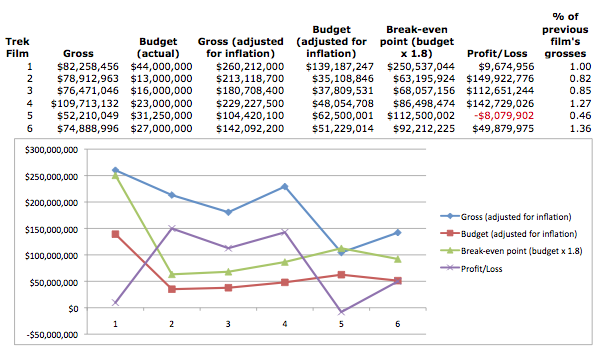Not sure if this has been posted here before but I don't see it, so I'll take the opportunity to link this interesting comparison of ST movie box office from the forums of startrek.com.
What's interesting about it is that the poster sourced worldwide and inflation-adjusted data for all the films, and compiled a list --the only such that I've seen -- of how profitable the films actually were. This result is this table:
Title..............................................Adjusted Profit
Star Trek: The Motion Picture................$328,952,000
Star Trek...........................................$261,403,995
Star Trek II: The Wrath of Khan.............$229,044,800
Star Trek IV: The Voyage Home.............$227,701,000
Star Trek: First Contact.......................$186,160,000
Star Trek III: The Search for Spock........$163,047,000
Star Trek: Generations.........................$155,554,000
Star Trek Into Darkness........................$142,450,586
Star Trek VI: The Undiscovered Country..$132,320,700
Star Trek V: The Final Frontier...............$80,400,000
Star Trek: Insurrection.........................$79,491,400
Star Trek: Nemesis..............................$9,879,628
There's more detail at the link, and also keep in mind that STiD may have moved up a rank or two since he posted this back in June of 2013. Nevertheless it is interesting to note that TMP was the most profitable film in the franchise, that ST09 was not very much more profitable than TWOK, and that STID in terms of profit comes somewhere in the middle of the pack.
(The list also makes lamentably clear why Nemesis was a franchise killer.)
What's interesting about it is that the poster sourced worldwide and inflation-adjusted data for all the films, and compiled a list --the only such that I've seen -- of how profitable the films actually were. This result is this table:
Title..............................................Adjusted Profit
Star Trek: The Motion Picture................$328,952,000
Star Trek...........................................$261,403,995
Star Trek II: The Wrath of Khan.............$229,044,800
Star Trek IV: The Voyage Home.............$227,701,000
Star Trek: First Contact.......................$186,160,000
Star Trek III: The Search for Spock........$163,047,000
Star Trek: Generations.........................$155,554,000
Star Trek Into Darkness........................$142,450,586
Star Trek VI: The Undiscovered Country..$132,320,700
Star Trek V: The Final Frontier...............$80,400,000
Star Trek: Insurrection.........................$79,491,400
Star Trek: Nemesis..............................$9,879,628
There's more detail at the link, and also keep in mind that STiD may have moved up a rank or two since he posted this back in June of 2013. Nevertheless it is interesting to note that TMP was the most profitable film in the franchise, that ST09 was not very much more profitable than TWOK, and that STID in terms of profit comes somewhere in the middle of the pack.
(The list also makes lamentably clear why Nemesis was a franchise killer.)



 That sounds like it should be kind of... illegal?
That sounds like it should be kind of... illegal?